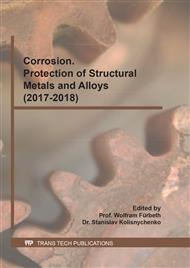p.190
p.196
p.201
p.207
p.217
p.223
p.228
p.233
p.239
Corrosion Behaviors for Galvanizing, Galvalume and Chromate Treated Steels in 1% NaOH Solution
Abstract:
The galvanized steel structures may be inevitably corroded rapidly in the case of exposed to corrosive environments for long time, and these corrosive environments has been accelerated with increasing the environmental contamination due to the rapid development of industrial society. However, since the galvanizing method have the various merits compared to surface coating treatment in economical point of view, the galvanized steel have been extensively used to the numerous constructional steels such as a guard rail of high way, various types of structural steel for manufacturing ship and various industrial fields etc.. Therefore, it has been made an effort to improve the corrosion resistance of the galvanizing film through various methods such as variation of chemical composition of galvanizing bath, chromate treatment and coating treatment etc.. In this study, comparison evaluation on the corrosion resistance of three types of the test specimens, that is, three samples of pure galvanizing, galvalume and chromate treatment were investigated using electrochemical methods in 1% NaOH solution. The samples of chromate treatment and of galvalume exhibited the lowest and highest corrosion current density respectively in 1% NaOH solution. In addition, the sample of chromate treatment revealed the highest impedance at 0.01Hz, which is considered that the oxide film by chromate treatment is deposited on the surface of pure galvanizing sample. After drawing polarization curves, the corroded surface of the pure galvanizing specimen indicated pattern like as localized corrosion, moreover, the large amount of corrosive products was observed on the surface of galvalume sample. However, the smooth pattern nearly similar to general corrosion was observed at the corroded surface of the sample of chromate treatment. Consequently, it is considered that the chromate treatment is an optimum method compared to pure galvanizing and, galvalume treatment to improve corrosion resistance in 1% NaOH solution.
Info:
Periodical:
Pages:
217-222
Citation:
Online since:
July 2017
Authors:
Price:
Сopyright:
© 2017 Trans Tech Publications Ltd. All Rights Reserved
Share:
Citation:



